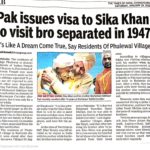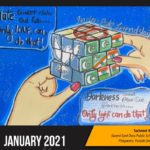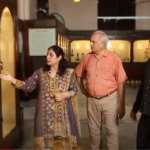A first-time author writes about her attempt to document nuances that can serve as a lifeline amidst an ongoing barrage of hate mongering
I was born in 1988, a year before the Kashmir conflict reached new heights that would bring India and Pakistan at the brink of war. As a young child during the 1990s, night after night I absorbed Pakistan Television’s Kashmir bulletin, a blood-filled broadcast, after prime time news. At the same time, Bollywood invaded common households through the VCR, a common commodity by then.
Like millions of Pakistanis, I was fascinated by the glamour of the film industry across the border. While Indian movie songs played at every wedding, the media continued to project the ‘other’ as a vicious and brutal force, an idea further entrenched by my school textbooks and by the mainstream discourse in society. India thus came to represent an ‘exotic enemy.’
My maternal grandmother was in her early twenties and lived in Lahore at the time of Partition. She and her siblings volunteered their services at the refugee camp at Walton. As a child, I heard countless stories of violence and massacre, of blood-strewn trains and butchered bodies that she helped bury.
In school, history textbooks blatantly called Hindus mischievous and treacherous and the drawing room conversations seldom differed. In the process, I became schooled in the doctrine of suspicion and mistrust of the ‘other.’
It wasn’t until much later that further education and exposure to young Indians abroad began to challenge some of the misconceptions I had embraced in my childhood. However, it was my work with the Citizens Archive of Pakistan (CAP) starting in 2010 that became the driving force behind breaking stereotypes for me.
Leading the Oral History Project in Lahore and Islamabad for CAP, I had to go out and record narratives of Partition survivors on an everyday basis. It was during this process that I began to hear narratives that were different from what I had absorbed until then. For the first time I heard about divided families longing to reconnect, I heard about people coming to rescue those belonging to other religious communities at Partition, and I heard about the longing and desire to revisit one’s home and neighbourhood left behind on the other side of the line.
In both India and Pakistan, nationhood and patriotism is built by defining ourselves in opposition to the ‘other.’ In doing so, looking nostalgically or fondly towards the other side becomes equated with being a traitor. So I found it baffling that Partition survivors, who had suffered the bloodshed and violence of 1947 first hand, could want to go back and want to revisit their past.
In the process of these interviews, I learnt about a festival that takes place at the border in Kasur during the Sawan months (July-August) according to the indigenous calendar. Hindus, Muslims and Sikhs come together to pray at a shrine located on the zero line that locals refer to simply as the “mela at the mazar”. Later, I found out about several other such festivals in Pakistan, like Baisakhi at Ram Thamman, Kasur district, where Muslims and non-Muslims come together to celebrate.
This connection, these sustained bonds, which seemed to persist even six decades after Partition, were mindboggling for someone like me. Growing up in the 1990s, my generation constantly heard about the divide between India and Pakistan and between Hindus, Muslims and Sikhs, a divide that seemed to have always existed.
Later, when I launched CAP’s Exchange-for-Change project linking thousands of schoolchildren in India and Pakistan through letters, postcards and visits across the border, I learnt that the misconceptions I had held onto were mirrored in these children too. In both India and Pakistan, at tender ages of ten to fourteen, they had already made up their minds about the ‘other’.
Many of the Pakistani children thought of Indians as treacherous infidels, while for the Indian children thought Pakistanis were barbaric terrorists. They seemed bitterer, angrier at Partition than even their own grandparents who had witnessed 1947. There was no room left to talk, to learn, to visit the same people that many of their grandparents ached to reconnect with.
 But as they interacted, the hostility transformed into curiosity for many of the children. After exchanging two letters, a child came up to me and said, “Teacher, these Indians are just like us. They also like gulab jamans there, you know?”
But as they interacted, the hostility transformed into curiosity for many of the children. After exchanging two letters, a child came up to me and said, “Teacher, these Indians are just like us. They also like gulab jamans there, you know?”
By simply opening direct communication channels, children on both sides of the border were able to learn about the ‘other’ from the ‘other.’ A few months later, when I took a delegation to India, the same students who did not want to write a letter to each other did the bhangra dance on stage together. Sadly, not every child has the opportunity to access counterparts across the border. For most, the other side remains figments of their imagination. An imagination tainted by the distortions and biases we are fed on both sides of the divide.
It was this disconnect between the young children and the Partition generation, who still serve as living sources of history that pushed me to write this book. Through it, I have attempted to explore how the perception of Partition and the ‘other’ has evolved over four generations of Pakistan and India. It seems like wars, religious extremism and terrorism have left new imprints on 1947; imprints only solidified by media propaganda, distorted history textbooks and filtered oral histories on both ends of the border.
It is my finding that for many Partition survivors, the general trauma of 1947 has been personalized and the master narratives of hatred and animosity have come to impact private memories and histories, filtering them to such an extent that often fonder memories of a more peaceful time have receded to the back. Violent and bloody memories are at the tip of the tongue for many survivors and as a result, for their children and grandchildren.
However, the good memories often come to the forefront through this anecdote or that, and come to nuance the black and white narratives predominant in society today. It is these nuances, which can serve as a lifeline amidst the constant hate mongering that we seem to be drowning in.
As we lose more and more people from the partition generation, we find ourselves in a precarious position. With the loss of Partition survivors, we are also at the risk of losing those nuances, those anecdotes, those stories of rescue, those memories of friends and neighbours who lived together for generations. It is then perhaps the most urgent task to recover these narratives and to restore them so we can provide a challenge to the mainstream discourse on both sides of the border. ‘Footprints of Partition’ is a humble attempt as part of this process.
Anam Zakaria is a development professional, educationist and researcher based in Islamabad, Pakistan. The Footprints of Partition: Narratives of Four Generations of Pakistanis and Indians (Harper Collins, India, 2015) is her first book.
Email: [email protected]












